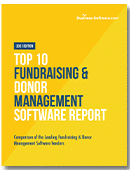ERP
Choosing the Right Performance Metrics for Non-Profit Organizations

Success in any business environment requires an ability to define what performance looks like and accurately measure performance and results.
In the world of non-profit organizations, this measurement becomes more important and complex because financial profit, or return on investment, is never the ultimate goal. There is another set of metrics involved, and determining what they should be is crucial to the ability to control and measure performance, and ultimately to optimize resources and deliver successful outcomes.
In broad terms – non-profit organizations (NPOs) work towards the fulfillment of a fundamental change in society — often referred to as the mission. At the highest level, they need to define the mission clearly so that it can be converted into specific goals and results.
Here’s an example – an NFP could be initiated to “help the homeless”. This is clearly a worthy goal that has come about because of a need in society – but it will be difficult to measure performance and results unless the specific objectives are more clearly defined. If prevention is the ultimate goal – then an overall decrease in homelessness within a defined area may be considered the best measure of success. However, the NPO may be more inclined to measure success by the quantifiable number of homeless people they have assisted to find homes – within a defined area. Clearly, success in one area does not necessarily lead to a successful outcome in the other.
Key Performance Indicators
Establishing key performance indicators or KPIs are a proven way for an NPO to evaluate and measure progress towards those identified goals. KPI’s are quantifiable measurements that reflect the specific goals, and are often integral to success of the NPO or a particular program. This is because they can assist the NPO to learn and improve their processes as well as provide relevant information to inform future management decision making.
KPIs begin with a target and then the establishment of a method to measure performance against that target. Referring to my earlier example – the goal of providing or finding shelter for homeless people within a geographic area may be the target. Number and rate of effectiveness (i.e. clients served per month) towards that goal can now be measured. This is a process oriented and mission-related KPI that measures operational effectiveness within the overall goal (outcome) of decreasing homelessness in society.
Financial Benchmark KPIs
Financial benchmark KPI’s may be utilized to measure the desired result from the money that is invested – i.e. divide the dollars spent by the number of people who were formerly homeless.
CAWST, the Centre for Affordable Water and Sanitation Technology in Calgary, Alberta, has employed this type of KPI (in addition to others) in their 2012 Annual Report – defined as “Cost Per Person Impacted – measuring the efficiency of CAWST interventions and calculated as the cumulative CAWST expenditure divided by the cumulative number of people impacted by CAWST clients.”
CAWST has demonstrated with this KPI — not only efficient usage of funds, but yearly trend analysis shows impressive improvements and stability over time.
Within the category of process oriented KPI’s — business process metrics can also be tracked– such as maintenance of optimum AR/AP ratios, production time for periodic financial statements, employee turnover ratios, and so on. Business process metrics clearly fall within the realm of effective management and are important to the overall efficiency and effectiveness of the NPO.
NPOs have many stakeholders, and many of these are active and relevant participants in driving successful outcomes. Donors and funders in particular desire confirmation that the organization they are supporting is operating in an efficient manner (i.e. business process metrics), and they expect to see reliable and credible measures of performance with respect to outcomes (programmatic or mission related KPI’s). There are also external reporting requirements to comply with and numerous requests for information from stakeholders.
High Accuracy Means More Data
Analysis with a high degree of accuracy invariably requires extensive data collection as well as the means of reporting and utilizing to measure past performance and results, and subsequently influence decision making in the future.
Competition for funding has always been an element in the NPO environment, and there is an increasingly prevalent need to identify new sources of funding as well as retain existing funding sources.
I have noted in my experience working with NPOs that the most flourishing organizations are those that have clearly identified their goals, and have developed business processes, abilities and methods to quickly and accurately report on identifiable “critical measures of success”.
 A reliable, flexible and comprehensive financial accounting and management solution such as MS Dynamics NAV is one of the tools that can provide assistance with the herculean task of tracking a variety of variables and critical financial data across multiple time frames.
A reliable, flexible and comprehensive financial accounting and management solution such as MS Dynamics NAV is one of the tools that can provide assistance with the herculean task of tracking a variety of variables and critical financial data across multiple time frames.
Serenic Navigator, certified for MS Dynamics NAV, combines this same advanced technology as well as fund accounting features to deliver an integrated accounting software solution specifically for NPOs.
 How successful is your organization at measuring performance and results?
How successful is your organization at measuring performance and results?
[Reposted from the CatapultERP Blog]
For a side-by-side comparison of the industry’s top nonprofit software solutions, make sure to download Business-Software.com’s free Top 10 Nonprofit Accounting Software report or the Top 15 Nonprofit Donor Management Software report. We give you the low-down on the industry’s top solutions by comparing pricing, features and deployment methods of the top nonprofit accounting software.






